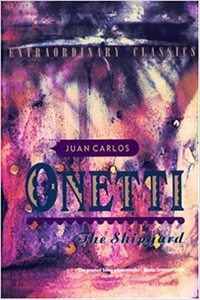Take a photo of a barcode or cover
dark
reflective
sad
medium-paced
Onetti demuestra en esta novela la necesidad de adaptar el contenido de una obra a la naturaleza del mensaje. Muchas veces se han alentado debates en los que se han comparado estilos tan dispares como el de Faulkner y el de Hemingway, obviando el hecho de que ni Faulkner cuenta historias de acción, ni Heminway se detiene en la introspección intelectiva.
Dicho esto, "El astillero" bebe directamente del estilo faulkneriano y, como el premio Nobel, se detiene en lo mental y emocional; en este caso, en la sensación de sopor, hastío y vacío existencial de Larsen, el protagonista. En un primer acercamiento, cuesta hacerse al estilo tan excesivamente interiorizado de Onetti, sobre todo en la primera mitad. Cuando se cruza este límite, uno disfruta verdaderamente de la capacidad poética del uruguayo. Es un creador de atmósferas más que un psicólogo de los personajes porque, fuera de Larsen, no hay nada. Existencialismo en estado puro.
Dicho esto, "El astillero" bebe directamente del estilo faulkneriano y, como el premio Nobel, se detiene en lo mental y emocional; en este caso, en la sensación de sopor, hastío y vacío existencial de Larsen, el protagonista. En un primer acercamiento, cuesta hacerse al estilo tan excesivamente interiorizado de Onetti, sobre todo en la primera mitad. Cuando se cruza este límite, uno disfruta verdaderamente de la capacidad poética del uruguayo. Es un creador de atmósferas más que un psicólogo de los personajes porque, fuera de Larsen, no hay nada. Existencialismo en estado puro.
challenging
dark
slow-paced
Plot or Character Driven:
Character
Strong character development:
No
Loveable characters:
Complicated
Diverse cast of characters:
Complicated
Flaws of characters a main focus:
Yes
reflective
sad
slow-paced
Plot or Character Driven:
Character
Strong character development:
Yes
Loveable characters:
No
Diverse cast of characters:
Complicated
Flaws of characters a main focus:
Yes
Cada persona que me dijo que este libro es la viva imagen de la desolación tenía razón.
challenging
dark
reflective
slow-paced
Plot or Character Driven:
Character
Strong character development:
Complicated
mysterious
tense
slow-paced
Plot or Character Driven:
Character
Strong character development:
No
Loveable characters:
No
Diverse cast of characters:
No
Flaws of characters a main focus:
Yes
La lectura ideal para el día en que terminé de luchar contra la administración intentando apuntarme a unas oposiciones. El relato de los nadie que creen ser todo en medio de la nada, de la parálisis de la que uno no sólo no sabe huir, sino que aprende que seguramente no le convenga huir.
No me había gustado mucho, pero cuando lo comentamos en clase me di cuenta de muchas más cosas, y por eso le subo la calificación.
I got a quarter of the way in and just didn't care about anything happening in the book or the characters in it.
An interesting short novel, The Shipyard looks at Larsen, a man who has returned to Santa Maria, changed his name, and is now the (unpaid) manager of Petrus' struggling shipyard. Why is it struggling? WE don't know exactly, but there are but 3 employees, no running ships, broken down buildings, rusty machinery (which is being sold on the side in lieu of the 3 employees getting their salaries).
Why has "Larsen" returned? Why did he eave in disgrace? Does he think Mr Petrus will suddenly get--what, a government infusion of money? Does he hope to marry Petrus' weak-minded daughter Angelica Ines before that infusion comes?
And Galvez and Kunz, the other 2 employees (also not paid)--what do they think they will gain? How did they end up here?
There is a second book to this 2-book series, which apparently explains the happenings before this book. I think I need to get it, as I am horribly curious as to what all is being insinuated and hinted at. I expect that a better knowledge of Uruguayan/Latin American politics would explain a bit of this story--but I don't have it.
Why has "Larsen" returned? Why did he eave in disgrace? Does he think Mr Petrus will suddenly get--what, a government infusion of money? Does he hope to marry Petrus' weak-minded daughter Angelica Ines before that infusion comes?
And Galvez and Kunz, the other 2 employees (also not paid)--what do they think they will gain? How did they end up here?
There is a second book to this 2-book series, which apparently explains the happenings before this book. I think I need to get it, as I am horribly curious as to what all is being insinuated and hinted at. I expect that a better knowledge of Uruguayan/Latin American politics would explain a bit of this story--but I don't have it.



